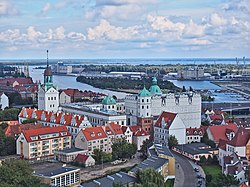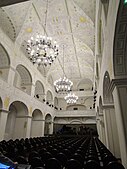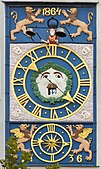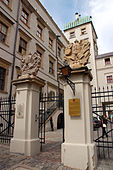Ducal Castle, Szczecin
| Ducal Castle | |
|---|---|
 General view of the castle | |
 | |
| General information | |
| Architectural style | Gothic, Pomeranian mannerism |
| Town or city | Szczecin |
| Country | Poland |
| Coordinates | 53°25′34″N 14°33′37″E / 53.42611°N 14.56028°E |
| Construction started | 1346 |
| Completed | 1428 |
| Renovated | 1958–1980 |
| Design and construction | |
| Architect(s) | Wilhelm Zachariasz Italus (mannerist reconstruction) |
The Ducal Castle, also known as the Pomeranian Dukes' Castle,
History
Barnim the Great of Pomerania-Stettin erected the castle within Szczecin's walls against the will of the burghers in 1346. An older Pomeranian burgh had been leveled in 1249.[1] In 1490 the castle was partially reconstructed for Bogusław X's wedding with Anna Jagiellonka (daughter of king Casimir IV Jagiellon).[2]
Between 1573 and 1582 the castle was rebuilt again, this time in the
In 1648, due to the tenets of the
After the
Under Swedish and later Prussian rule, the castle was extensively modified. In 1840-1842 a tower in
Polish conservations maintain that these modifications under Prussian rule in the 19th were barbaric,[6] devastating the many Renaissance elements in the castle (arcades, attics, vaulting).[2] Eventually about 60% of the castle was destroyed during World War II (August 1944).[5]
Under Polish rule, the castle was rebuilt between 1958 and 1980 with some modifications. The castle was seen as a point of contact with the town's lost Slavic past, supporting and legitimizing the
Gallery
-
View from one of the towers
-
The Ducal Castle in Szczecin
-
The tower seen from the courtyard
-
Side view with one of the towers
-
Inner courtyard
-
Former castle chapel
-
Clock on the castle's clock tower
-
One of the chambers
-
Gate
-
Culture and Tourism Center
See also
- List of mannerist structures in Northern Poland
- Castles in Poland
Notes
References
- ISBN 3-88680-272-8
- ^ a b c "History". zamek.szczecin.pl. Retrieved 2009-12-28.
- ^ a b "Historia". zamek.szczecin.pl (in Polish). Archived from the original on 2010-01-20. Retrieved 2009-12-28.
- ^ Kazimiera Kalita Skwirzyńska, Ewa Prync-Pommerencke. "Zamki i dwory renesansowe". www.pomorskiezamki.pl (in Polish). Archived from the original on 2007-08-29. Retrieved 2009-12-28.
- ^ a b c d e "Szczecin". www.zamkipolskie.com (in Polish). Retrieved 2009-12-28.
- ^ a b c Peter Oliver Loew, Christian Pletzing, Thomas Serrier (2006). Wiedergewonnene Geschichte: zur Aneignung von Vergangenheit in den Zwischenräumen Mitteleuropas (in German). Otto Harrassowitz Verlag.
{{cite book}}: CS1 maint: multiple names: authors list (link)










